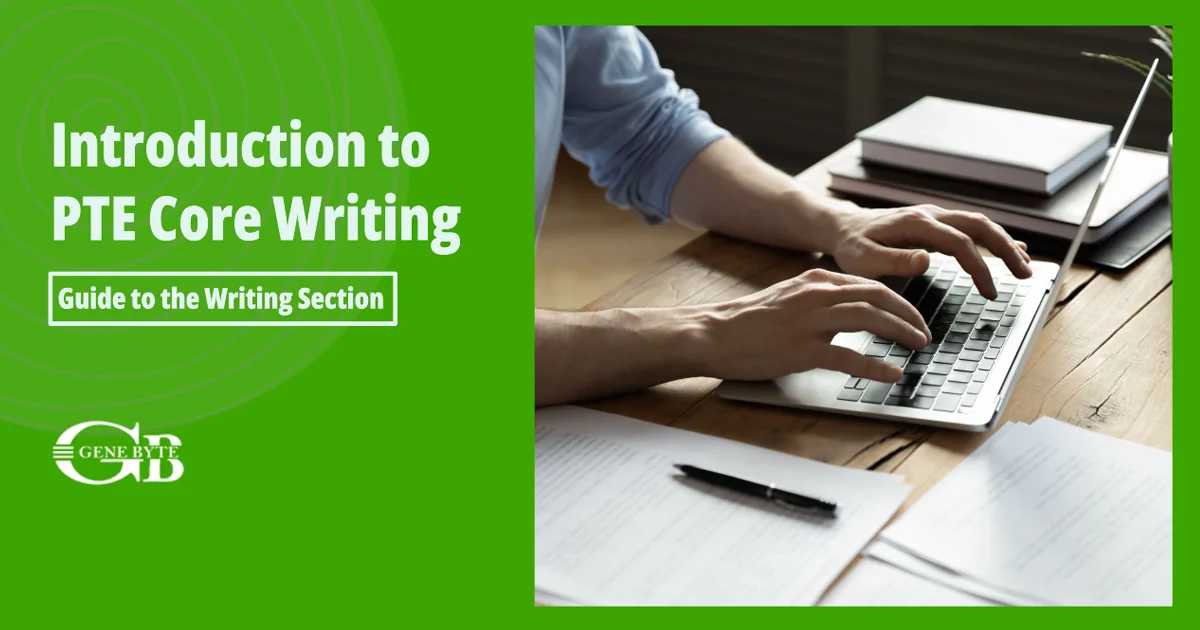PTE Core Insights:
PTE Core Writing for Educators
A Teacher's Guide to PTE Core Writing Section

"Transform your approach to PTE Core writing tasks with expert insights."
As a Management Executive at Genebyte, my mission is to arm educators with the tools they need to elevate their students' Pearson Test of English Core's Writing skills. The Writing Section in PTE Core test, is a critical component that tests a test taker's ability to convey their thoughts precisely and coherently. It challenges both their understanding and their ability to apply it under exam conditions. By focusing on these key aspects, we're not just preparing students for an exam; we're equipping them with skills that last a lifetime.
The Writing Section tests a candidate's ability to cohesively and coherently express ideas in written form, encompassing tasks such as Summarize Written Text and Write Email. The main objective of discussing the Writing Section for teachers is to shed light on the strategies and tools available to enhance student outcomes.
Through Genebyte's innovative solutions, educators are empowered to guide their students not only towards achieving high scores but also in mastering the art of effective written communication. This commitment to excellence underpins our approach, aiming to set new benchmarks in PTE Core preparation. Let's delve into how Genebyte's innovative approach is transforming PTE Core Writing preparation for educators and students alike.

Introduction to PTE Core Writing Section
The Writing section of the PTE Core exam plays a crucial role in evaluating test takers' abilities to express their thoughts in written English, aligning with the Canadian Language Benchmark (CLB Level) for Canada PR and immigration purposes. This section, designed for comprehensive assessment, tests the proficiency of candidates in everyday and workplace English through tasks like Summarizing Written Text and Writing Emails. Preceded by the the Speaking Section, it's a pivotal part of the exam that not only reflects a candidate's writing skills but also their ability to understand and interpret written information accurately.
Overview and Significance of PTE Core Writing
- Structure and Components: The Writing section consists of two main task types: Summarize Written Text and Write Email. Each task type is designed to assess different aspects of writing skills.
- Timing and Scoring: The total time allocated for the Writing section ranges from 28 to 47 minutes, depending on the number of tasks presented. Each task type has a separate timer, with 10 minutes for each Summarize Written Text question and 9 minutes for each Write Email question. The total score for the Writing section is a combination of scores from these tasks and integrated tasks from the Reading and Listening sections, emphasizing the integrated nature of the PTE Core exam scoring system.
- Importance of Templates and Strategy: While the Writing section evaluates subjective-style answers, employing a structured approach or templates, especially for the Write Email task, can significantly enhance a candidate's score. Templates provide a clear organizational structure and ensure that all required elements of the response are included, thereby maximizing the chances of achieving a higher score.
- Integrated Scoring: The PTE Core's integrated scoring system means that the Writing section not only contributes scores to the Reading section but also receives scores from the Reading and Listening sections. This highlights the interconnectedness of the sections and underscores the importance of a well-rounded preparation strategy that covers all aspects of the exam.
- Repetition and Memorization: Given that material from question items may get repeated across exams, familiarity with past questions and their answers can provide candidates with a significant advantage. Memorizing high-frequency topics and responses can help streamline the preparation process and increase efficiency during the exam.

The Revised Version of Summarize Written Text
Description and Objective
The Summarize Written Text question type in the PTE Core Writing section is a critical component that evaluates a test-taker's ability to comprehend, condense, and convey the essence of a given text. This task presents candidates with a text of up to 200 words and requires them to distill its primary message into a single, coherent summary of between 25 and 50 words. The essence of this exercise is not just to test the reading and writing prowess of the candidates but also their ability to identify the core ideas and present them succinctly, preserving the original meaning.
Scoring Criteria and Its Impact
The scoring for Summarize Written Text is multifaceted, considering not just the content's accuracy but also how well the response adheres to the word limit, the fluency and coherence of the writing, and the grammatical correctness. This task uniquely contributes to both the reading and writing scores, making it a pivotal area of focus for students aiming for high overall PTE scores. With a direct contribution of up to 14 points to the writing score and 10 to the reading score, mastering this task can significantly impact a candidate's performance.

The Latest Write Email Task and its Significance
The Write Email question type in the PTE Core Writing Section has replaced the Write Essay task from the PTE Academic Writing. This task demands test takers to write an email within 50 to 120 words based on a given situation. The task is designed to mimic real-life scenarios, where one might need to write emails for various purposes such as inquiries, responses, or proposals. This task assesses the student's overall English language proficiency by judging their ability to organize thoughts logically, use appropriate email conventions, and demonstrate proficiency in grammar and vocabulary, and also helps in general training.
Organizational Structure and Email Conventions
A well-structured email begins with a clear greeting, followed by an introduction to the subject matter, the main body containing the email's core message, and a polite closing. It's crucial for students to familiarize themselves with standard email conventions, tailoring their tone and structure to the prompt's requirements. Genebyte's platform offers templates that can significantly aid in structuring emails, ensuring that students adhere to these conventions while also allowing for personalization to suit the specific scenario at hand.
Scoring Criteria and Its Impact
The scoring for the Write Email task is multifaceted, focusing on grammar, vocabulary, spelling, and the email's overall organization and adherence to conventions. Each aspect of the email, from the greeting to the closing, contributes to the overall score. Understanding and teaching these scoring criteria are paramount for teachers, as it directly influences students' preparation strategies. Genebyte's solution emphasizes these criteria, providing detailed feedback and analysis that help both teachers and students identify areas of improvement.

Unraveling the Complexity of Integrated Scoring
In the realm of PTE Core, understanding the scoring algorithm is paramount for both teachers and students aiming for excellence. The Writing section, encompassing tasks such as Summarize Written Text and "Write Email," presents a unique challenge, wherein each response's value is meticulously calculated through a sophisticated algorithm. This section not only assesses one's ability to articulate ideas effectively but also contributes to and benefits from the Reading and Listening sections, embodying the test's integrated scoring system.
The Essence of Integrated Scoring
Integrated scoring stands as a cornerstone of the PTE Core evaluation process, ensuring a holistic assessment of a candidate's language proficiency. Unlike traditional scoring methods that treat each section in isolation, PTE Core's algorithm intricately links the Writing, Reading, and Listening sections. This integration means that the performance in one section can significantly influence the overall score, promoting a comprehensive understanding and application of the English language.
For instance, a well-crafted email in the Writing section not only demonstrates proficiency in structuring and conveying messages but also requires an understanding of the context provided in Reading passages or Listening excerpts. Similarly, responses in the Writing section can enhance comprehension scores in Reading and Listening, highlighting the interdependence of skills across sections.
Navigating the Complex Algorithm
The scoring algorithm of the PTE Core delves into various factors beyond mere correctness. It evaluates the relevance, fluency, and overall quality of responses, with each item contributing differently to the score. For example, the Write Email task is valued for its ability to simulate real-world communication scenarios, requiring candidates to adhere to email conventions, organize thoughts coherently, and express ideas with clarity and precision.
The algorithm assigns weights to different aspects of a response, such as content, form, grammar, and vocabulary range. These weights are not fixed but vary according to the task's difficulty level and the average performance of test-takers, ensuring a fair and adaptive assessment process. For teachers, this underscores the importance of guiding students to focus not just on accuracy but on the quality of their communication.
Templates: A Tool for Success
A notable feature of the Writing section is the strategic use of templates, particularly in the Write Email task. Templates serve as a valuable tool for structuring responses, ensuring that all required elements are present and correctly formatted. However, it's crucial for teachers to emphasize the importance of customization and personalization within these templates. Rote memorization of templates without understanding the context or the ability to adapt them to specific prompts may not yield the desired scores.

Time Management in the Writing Section
Achieving excellence in the PTE Core Writing section necessitates not only linguistic proficiency but also astute time management. This segment elucidates strategies for effective allocation of time to the tasks of Summarizing Written Text and Writing Email, essential for optimizing performance and scores.
Summarize Written Text: A 10-Minute Tactical Approach
For the Summarize Written Text item, candidates are allocated 10 minutes. This timeframe is to be utilized for reading the text, planning the summary, writing, and finally editing it. The objective is to condense the text into a summary of 25 to 50 words, honing in on the core ideas while maintaining clarity and coherence.
Time Allocation Strategy:
- Reading & Understanding (3 minutes): Initially, spend about three minutes reading the text to grasp the main idea and key points. Skimming and scanning efficiently can aid in this process.
- Planning & Structuring (2 minutes): Allocate the next two minutes to planning your summary. Identify the thesis statement and supporting arguments to construct a coherent narrative.
- Writing (3 minutes): Use the subsequent three minutes to draft your summary. Focus on succinctness and accuracy.
- Review & Edit (2 minutes): Reserve the final two minutes for revising your summary. Check for grammatical accuracy, adherence to the word limit, and the inclusion of main ideas.
Write Email: Navigating the 9-Minute Challenge
When tasked with Writing Email, candidates are given 9 minutes. This encompasses the entire process from understanding the prompt to composing and refining the email within the specified word count (50-120 words).
Time Allocation Strategy:
- Understanding the Prompt (1 minute): Spend the initial minute thoroughly reading the prompt to understand the context and requirements.
- Planning & Outlining (2 minutes): Dedicate two minutes to organizing your thoughts and structuring the email. Consider using the Erasable Note Board for jotting down points.
- Writing (4 minutes): Allocate four minutes to the actual writing process. Ensure you cover all required points, following the conventional structure of an email.
- Proofreading & Editing (2 minutes): Use the last two minutes to proofread your email. Focus on correcting spelling, grammar, and ensuring the tone and format align with the prompt's expectations.
Effective Time Management Tips:
- Adhere to Allocated Times: Each task has a set time limit; do not exceed it. Unused time does not carry over to subsequent tasks.
- Utilize Every Minute: Given that saved time does not benefit other tasks, it is crucial to utilize the entirety of the allotted time for each task, ensuring thoroughness in understanding, writing, and reviewing.
- Practice Makes Perfect: Regular practice under timed conditions can significantly improve your ability to manage time efficiently, allowing for a smoother execution during the actual test.

The Importance of Practice and Familiarity
Mastering the Writing Section of the PTE Core exam is crucial for teachers guiding students towards achieving their desired scores. This part of the exam assesses candidates' ability to produce written English in an academic context, comprising tasks like Summarize Written Text and Write Email. These tasks not only evaluate the test-takers' grammatical accuracy and coherence but also their ability to concisely convey complex ideas.
Revisiting Previous Question Items: A Path to Better Scores
-
Benefit of Repetition:
- Revisiting and practicing with previous question items familiarizes students with the test's format and the types of prompts they can expect. This repetition aids in developing a more instinctive response to tasks, improving both speed and accuracy.
-
Strategies for Effective
Memorization:
- Active Recall: Encourage students to practice by recalling question types and their strategies without looking at notes.
- Spaced Repetition: Utilize this technique by scheduling practice sessions at increasing intervals to enhance memory retention of question types and strategies.
-
Application of Known Material:
- Applying memorized strategies and templates to new but similar tasks can significantly improve efficiency and confidence, leading to better scores.
Strategies for Memorizing and Applying Known Material
-
Use of Templates for Write Email
Tasks:
- While creativity is essential, familiarizing oneself with effective templates for email tasks can provide a solid structure that students can adapt, ensuring they meet the formal requirements while saving time during the exam.
-
Practicing with a Focus on Time
Management:
- Each task in the Writing Section comes with a strict time limit. Practicing under timed conditions helps students develop the ability to allocate their time effectively, ensuring they can complete their responses without feeling rushed.
-
Analysis and Reflection:
- After practicing with previous question items, it's crucial to analyze the responses. Identifying common mistakes and understanding why certain answers worked well allows for targeted improvement.
-
Integration of Feedback:
- Incorporating feedback from practice sessions into future responses is vital. This could mean adjusting templates, refining time management strategies, or focusing on areas of weakness like vocabulary or grammatical accuracy.

Using Templates to Maximize Efficiency and Scores
In the PTE Core Writing Section, the use of templates, especially for the Write Email task, embodies a strategic approach to enhance both the efficiency and quality of student responses. This section of our discussion illuminates the role of templates in structuring responses, their limitations, and the benefits they bring to achieving higher scores. Ironically enough, in the upcoming Reading section, you cannot use any templates at all.
The Role of Templates in the Write Email Task
Templates offer a foundational structure for emails, ensuring that responses adhere to the conventional format required by the task. This includes a clear introduction, body, and conclusion, alongside appropriate greetings and sign-offs. The use of templates in the Write Email task is particularly beneficial as it guides students to effectively organize their thoughts and address the prompt's requirements within the specified word limit.
Benefits of Template Usage:
- Efficiency: Templates streamline the writing process, saving time by providing a ready-made structure that students can quickly adapt to fit the prompt.
- Consistency: Ensures a consistent approach to addressing different types of email scenarios, improving the overall coherence and readability of responses.
- Score Improvement: By adhering to the expected format and covering all necessary components of an email, students can improve their scores, as the structure is a significant factor in the evaluation process.
Limitations of Relying Solely on Templates
While templates serve as an invaluable tool in preparing for the Write Email task, over-reliance on them without understanding or adaptation can be counterproductive. Templates should not be used as a one-size-fits-all solution but should be adapted to fit the specific context and requirements of each prompt.
Strategies for Effective Template Utilization:
- Customization: Encourage students to personalize templates based on the prompt, adding specific details and varying language to fit the context.
- Understanding Context: Teach students to analyze the prompt thoroughly to ensure the template used aligns with the email's purpose and tone.
- Beyond Templates: Focus on developing students' ability to generate content independently of templates, enhancing their flexibility and creativity in response to diverse prompts.

Actionable Tips for Educators to Tackle the Writing Section
As we wrap up our exploration of the Writing section in the PTE Core, it's crucial for educators and coaching institutes to leverage the insights and strategies discussed to optimize their teaching methodologies. Genebyte's B2B SaaS solution emerges as a powerful ally in this endeavor, providing an array of features tailored to enhance the writing skills of students preparing for the PTE Core. Following the Writing section, students face the Reading Section next, where templates cannot be used.
- Embrace Template Usage: While templates in the Write Email task can significantly boost students' scores by providing a structured approach to their responses, it's essential to teach students the art of personalizing these templates to fit various contexts, ensuring their writing remains authentic and engaging.
- Focus on Core Skills: Encourage students to hone their grammar, spelling, and vocabulary through our platform's comprehensive language skill assessment tools. This focus on enabling skills ensures students not only meet the word count and formal requirements but also excel in delivering quality content.
- Incorporate Technology in Learning: Utilize Genebyte's AI-Evaluated Practice Tests and Skill Exams to offer students real-time feedback on their writing. This technology-driven approach facilitates a deeper understanding of the PTE Core's scoring criteria and helps students identify areas for improvement.
- Enhance Learning with Recorded Lectures: Make the most of Genebyte's recorded lectures and strategies feature to provide students with additional resources on tackling the Writing section effectively. These resources can be especially beneficial for visual learners.
Implementing the Genebyte Solution:
Genebyte's B2B SaaS platform stands out as a comprehensive solution for coaching institutes aiming to elevate their PTE Core preparation offerings. By integrating our software, institutes can provide students with personalized learning experiences, from automated scoring in mock and practice tests and real-time feedback to a vast repository of practice questions and recorded lectures. Our emphasis on template usage for the Write Email task, coupled with advanced analytics for education, positions Genebyte as an indispensable tool in the arsenal of educators dedicated to their students' success with their PTE Core results.
To discover more about how Genebyte can transform your coaching institute's approach to PTE Core English test preparation, we invite you to explore our platform further. Sign up for a trial or contact us for a demonstration today, and take the first step towards redefining PTE Core success for your students. Together, let's unlock their potential and pave the way for their academic and professional achievements.
Frequently Asked Questions
The PTE Core Writing section is structured to assess a candidate's ability to produce written English in an academic setting. It comprises two main tasks: Summarize Written Text and Write Email. These tasks test the ability to condense information and communicate effectively in written form.
Candidates must adhere to the specific word limits set for each task type, ensuring clear and concise responses. Additionally, submissions should follow standard email conventions for the Write Email task and succinctly capture the essence of the text in the Summarize Written Text task.
Responses are evaluated based on several criteria, including grammatical accuracy, coherence, relevance to the prompt, and adherence to the word limit. The scoring algorithm also considers factors like task difficulty and the average performance of test-takers.
Templates offer a structured approach for the Write Email task, helping candidates efficiently organize their responses. While templates can guide structure and format, customization to fit the specific prompt is crucial for achieving higher scores.
Integrated scoring means that performance in the Writing section can influence scores in the Reading and Listening sections and vice versa. This system emphasizes the interconnectedness of language skills across the exam.
Effective strategies include practicing with previous question items, utilizing templates for the Write Email task with appropriate customization, and focusing on time management to allocate sufficient time for planning, writing, and reviewing.
The Writing section's score is a composite of the individual task scores, contributing to and benefiting from the integrated scoring system. The total score for the Writing section can significantly impact the overall PTE score.
The maximum score achievable in the PTE Core Writing section is a part of the total PTE score, with each task contributing to the overall Writing score. The total Writing Skill score can go up to 90, integrating scores from related tasks in Reading and Listening.
Performance in the Writing section directly impacts the overall English proficiency score, with integrated scoring linking Writing skills to Reading and Listening competencies. Excelling in Writing can thus enhance the composite English proficiency score.
There are two main types of questions in the PTE Core Writing section: Summarize Written Text and Write Email, each assessing different aspects of written communication skills.
Time allocation for the PTE Core Writing tasks varies: 10 minutes for each Summarize Written Text question and 9 minutes for each Write Email task, with the total section time ranging from 28 to 47 minutes.
Practicing with previous PTE Core Writing questions can significantly improve preparation by familiarizing candidates with the exam format, common topics, and the application of effective strategies for each task type.